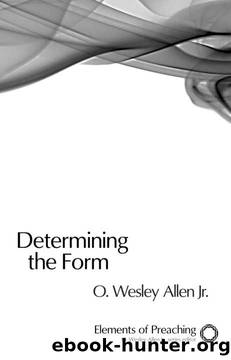Determining the Form: Structures for Preaching (Elements of Preaching) by O. Wesley Allen

Author:O. Wesley Allen [Allen, O. Wesley]
Language: eng
Format: epub
Published: 2009-07-06T15:48:00+00:00
The Form
This sermonic form works in a pendulum fashion, moving back and forth between exegesis of the text and its application. I am using "application" here in the broadest sense of describing the contemporary relevance of the ancient text, not the more narrow sense used in the Exegesis-Interpretation-Application form. In this form the application sections of the sermon really collapse theological interpretation and connection to the contemporary situation into one element. The assumption behind this is that there is an easy (not necessarily simplistic) move to be made between the text and the contemporary situation of the hearers, that an analogy between the manifestation of the human condition and of God's addressing that condition in the text on the one hand and contemporary expressions of the human condition and the gospel on the other is readily available.
So this form works as a sort of running commentary on the passage for the day. This does not mean that the sermon engages in the kind of technical exegesis we find in a biblical commentary. This is a homiletical commentary, with a narrow, specific audience/congregation in mind. Although this approach is called expository, the goal is not simply exegetical description of the text. The goal is proclamation of the gospel. Commentaries explain, they do not proclaim. Running commentary, therefore, is the form, not the purpose.
To use this sermonic form, preachers must identify the major divisions of the text. Verse-by-Verse is really a misnomer. Versification of the Bible has only been around since the Middle Ages. These chapter and verse divisions were made for the sake of common reference and do not necessarily reflect the structural logic used by the original author. Thus, the occasional sermon of this type may divide the passage in accordance with individual verses, but more often each move of the sermon will focus on longer sections of the passage made up of several verses.
By following the structure and flow of the text, this sermonic form allows the text to determine the logic of the sermon itself. Most biblical texts unfold in an inductive manner, especially narrative passages. The "punch line" is at the end-God gives the rainbow as a sign of the covenant, Solomon receives wisdom, Jesus heals the Canaanite woman's daughter, or Jesus answers a question with a parable. Verse-by-Verse sermons on such passages work inductively, allowing the text to reveal its emphasis at it own pace. There are, of course, biblical texts that function deductively-a prophetic passage that opens with a general critique of religious practice in the face of social injustice and then unpacks it, or an epistle passage in which Paul makes a broad theological or ethical claim and then supports it. Using this form to preach on texts such as these will result in deductive sermons. In Verse-by-Verse sermons, the form of the passage provides the skeletal structure of the sermon.
Having named that fact clearly, it is important to recognize that there is more often than not no single, correct way to divide a biblical text.
Download
This site does not store any files on its server. We only index and link to content provided by other sites. Please contact the content providers to delete copyright contents if any and email us, we'll remove relevant links or contents immediately.
Evangelism In a Skeptical World: How to Make the Unbelievable News About Jesus More Believable by Sam Chan(214)
Emotionally Healthy Discipleship by Peter Scazzero(172)
Evangelism Without Additives by Jim Henderson(170)
The Witness of Preaching, Third Edition by Long Thomas G(165)
How to Preach a Dangerous Sermon by Frank A. Thomas(163)
Transforming Fellowship: 19 Brain Skills That Build Joyful Community by Chris M Coursey(153)
The Art of Preaching Old Testament Narrative by Steven D. Mathewson(143)
Contagious Disciple Making: Leading Others on a Journey of Discovery by David Watson & Paul Watson(138)
Sermons of St. Alphonsus: For All the Sundays of the Year by St. Alphonsus Liguori(137)
Reciprocal Missions: Short-Term Missions that Serve Everyone by Steiner Phil & Schuetze DJ(129)
Captured Fire: The Sunday Homilies, Cycle B by Krempa S. Joseph(127)
Smart Sermon: How to Preach Intelligent Biblical Sermons that Transform Lives by Reimar Vetne(120)
Determining the Form: Structures for Preaching (Elements of Preaching) by O. Wesley Allen(118)
How to Write and Preach a Sermon: Practical Advice for the New Preacher by Christopher Bentliff(112)
Preaching Better by Ken Untener(103)
Christian Missionary Engagement in Central Nigeria, 1857â1891 by Femi J. Kolapo(100)
Outreach and Renewal by McSherry James(97)
Recovered by Robby Gallaty & Rob Suggs & David Platt(90)
